2017 Peugeot 3008 Hybrid 4 ECU
[x] Cancel search: ECUPage 168 of 566
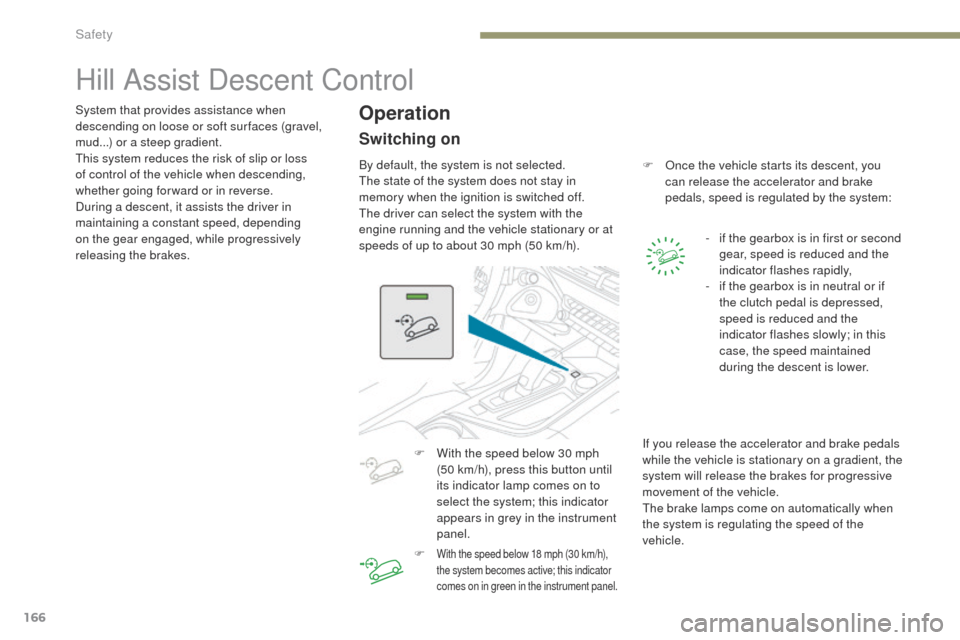
166
3008-2_en_Chap05_securite_ed01-2016
Hill Assist Descent Control
System that provides assistance when
descending on loose or soft sur faces (gravel,
mud...) or a steep gradient.
This system reduces the risk of slip or loss
of control of the vehicle when descending,
whether going forward or in reverse.
During a descent, it assists the driver in
maintaining a constant speed, depending
on the gear engaged, while progressively
releasing the brakes.Operation
By default, the system is not selected.
The state of the system does not stay in
memory when the ignition is switched off.
The driver can select the system with the
engine running and the vehicle stationary or at
speeds of up to about 30 mph (50 km/h).F
O nce the vehicle starts its descent, you
can release the accelerator and brake
pedals, speed is regulated by the system:
-
i
f the gearbox is in first or second
gear, speed is reduced and the
indicator flashes rapidly,
-
i
f the gearbox is in neutral or if
the clutch pedal is depressed,
speed is reduced and the
indicator flashes slowly; in this
case, the speed maintained
during the descent is lower.
Switching on
F With the speed below 30 mph (50 km/h), press this button until
its indicator lamp comes on to
select the system; this indicator
appears in grey in the instrument
panel.
F
With the speed below 18 mph (30 km/h),
the system becomes active; this indicator
comes on in green in the instrument panel.
If you release the accelerator and brake pedals
while the vehicle is stationary on a gradient, the
system will release the brakes for progressive
movement of the vehicle.
The brake lamps come on automatically when
the system is regulating the speed of the
vehicle.
Safety
Page 169 of 566
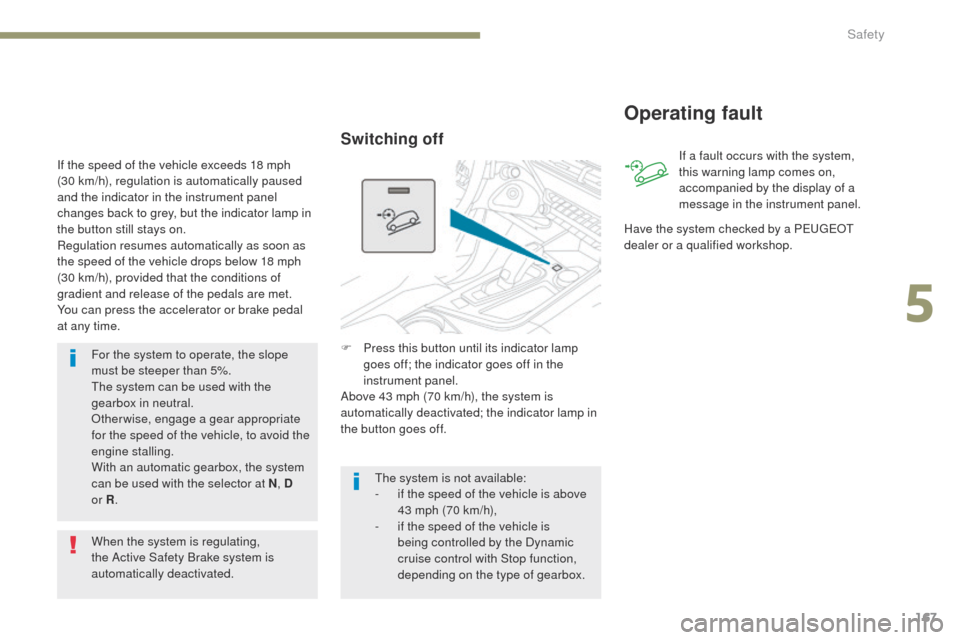
167
3008-2_en_Chap05_securite_ed01-2016
For the system to operate, the slope
must be steeper than 5%.
The system can be used with the
gearbox in neutral.
Otherwise, engage a gear appropriate
for the speed of the vehicle, to avoid the
engine stalling.
With an automatic gearbox, the system
can be used with the selector at N, D
or R .
If the speed of the vehicle exceeds 18 mph
(30
km/h), regulation is automatically paused
and the indicator in the instrument panel
changes back to grey, but the indicator lamp in
the button still stays on.
Regulation resumes automatically as soon as
the speed of the vehicle drops below 18 mph
(30 km/h), provided that the conditions of
gradient and release of the pedals are met.
You can press the accelerator or brake pedal
at any time.
Operating fault
If a fault occurs with the system,
this warning lamp comes on,
accompanied by the display of a
message in the instrument panel.
Have the system checked by a PEUGEOT
dealer or a qualified workshop.Switching off
F Press this button until its indicator lamp goes off; the indicator goes off in the
instrument panel.
Above 43 mph (70 km/h), the system is
automatically deactivated; the indicator lamp in
the button goes off.
The system is not available:
-
i
f the speed of the vehicle is above
43 mph (70 km/h),
-
i
f the speed of the vehicle is
being controlled by the Dynamic
cruise control with Stop function,
depending on the type of gearbox.
When the system is regulating,
the Active Safety Brake system is
automatically deactivated.
5
Safety
Page 170 of 566
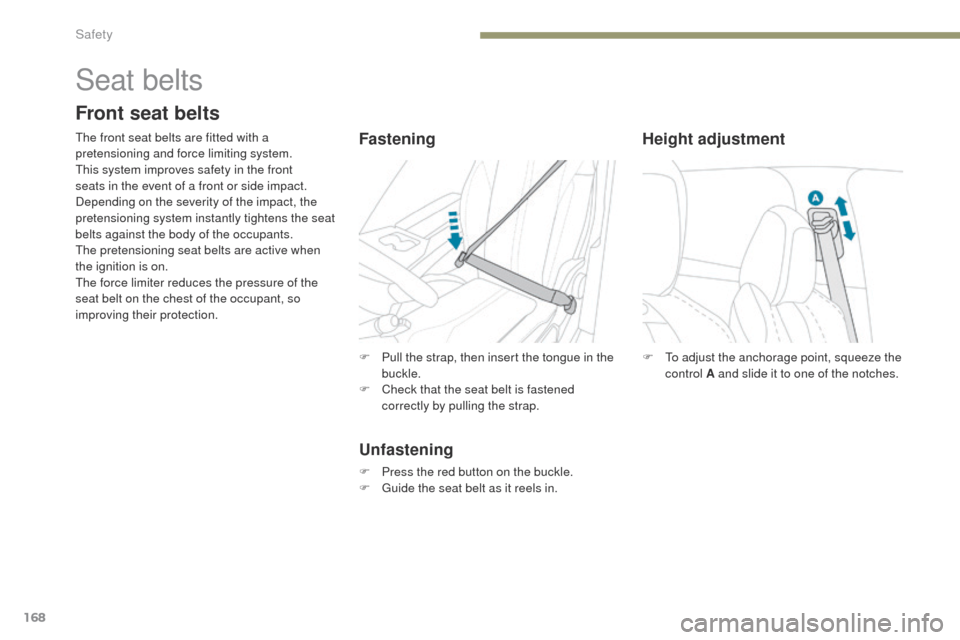
168
3008-2_en_Chap05_securite_ed01-2016
F To adjust the anchorage point, squeeze the control A and slide it to one of the notches.
Height adjustment
Seat belts
Front seat belts
The front seat belts are fitted with a
pretensioning and force limiting system.
This system improves safety in the front
seats in the event of a front or side impact.
Depending on the severity of the impact, the
pretensioning system instantly tightens the seat
belts against the body of the occupants.
The pretensioning seat belts are active when
the ignition is on.
The force limiter reduces the pressure of the
seat belt on the chest of the occupant, so
improving their protection.Fastening
Unfastening
F Press the red button on the buckle.
F G uide the seat belt as it reels in.
F
P
ull the strap, then insert the tongue in the
buckle.
F
C
heck that the seat belt is fastened
correctly by pulling the strap.
Safety
Page 171 of 566
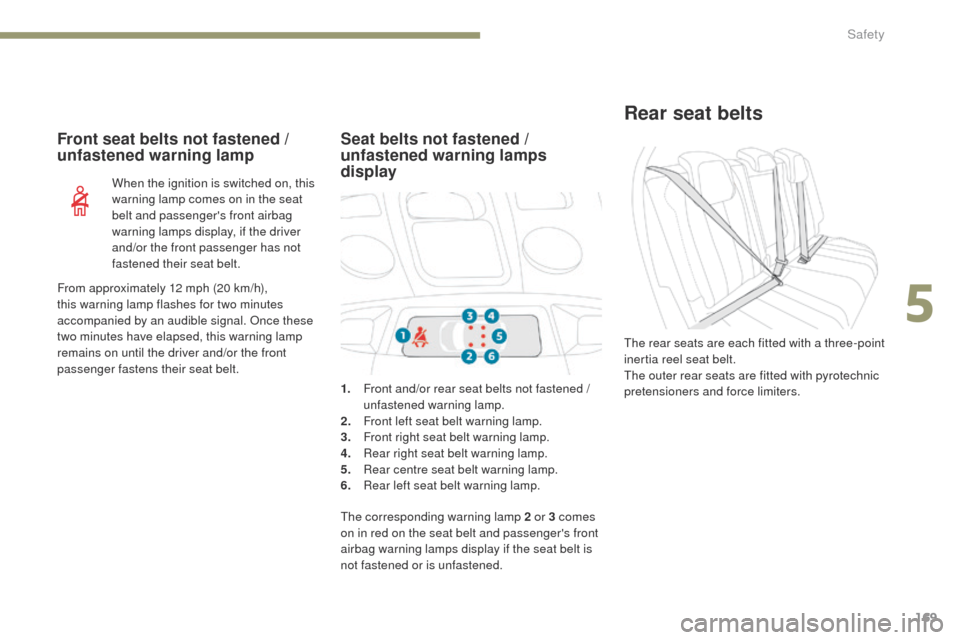
169
3008-2_en_Chap05_securite_ed01-2016
Rear seat belts
The rear seats are each fitted with a three-point
inertia reel seat belt.
The outer rear seats are fitted with pyrotechnic
pretensioners and force limiters.
Front seat belts not fastened /
unfastened warning lamp
When the ignition is switched on, this
warning lamp comes on in the seat
belt and passenger's front airbag
warning lamps display, if the driver
and/or the front passenger has not
fastened their seat belt.1.
F
ront and/or rear seat belts not fastened /
unfastened warning lamp.
2.
F
ront left seat belt warning lamp.
3.
F
ront right seat belt warning lamp.
4.
R
ear right seat belt warning lamp.
5.
R
ear centre seat belt warning lamp.
6.
R
ear left seat belt warning lamp.
Seat belts not fastened /
unfastened warning lamps
display
The corresponding warning lamp 2 or 3 comes
on in red on the seat belt and passenger's front
airbag warning lamps display if the seat belt is
not fastened or is unfastened.
From approximately 12 mph (20 km/h),
this warning lamp flashes for two minutes
accompanied by an audible signal. Once these
two minutes have elapsed, this warning lamp
remains on until the driver and/or the front
passenger fastens their seat belt.
5
Safety
Page 172 of 566

170
3008-2_en_Chap05_securite_ed01-2016
Fastening
F Pull the strap, then insert the tongue in the buckle.
F
C
heck that the seat belt is fastened
correctly by pulling the strap.
Unfastening
F Press the red button on the buckle.
F G uide the seat belt as it reels in. This warning lamp comes on in
the seat belt and passenger's front
airbag warning lamps display,
when one or more rear passengers
unfasten their seat belt.
Seat belt unfastened warning
lamp
Seat belt unfastened warning
lamps display
When the ignition is switched on, with the
engine running or when the vehicle is moving at
less than 12 mph (20 km/h), the corresponding
warning lamps 4
, 5 and 6 come on in red for
approximately 30 seconds, if the seat belt is not
fastened.
When the vehicle is moving at more than
12
mph (20 km/h), the corresponding warning
lamp 4 , 5 or 6 comes on in red, accompanied
by an audible signal and the display of a
message, if a rear passenger has unfastened
their seat belt.
From approximately 12 mph (20 km/h),
this warning lamp flashes for two minutes
accompanied by an audible signal. Once the
two minutes have elapsed, this warning lamp
remains on until one or more rear passengers
fasten their seat belt.
Safety
Page 173 of 566
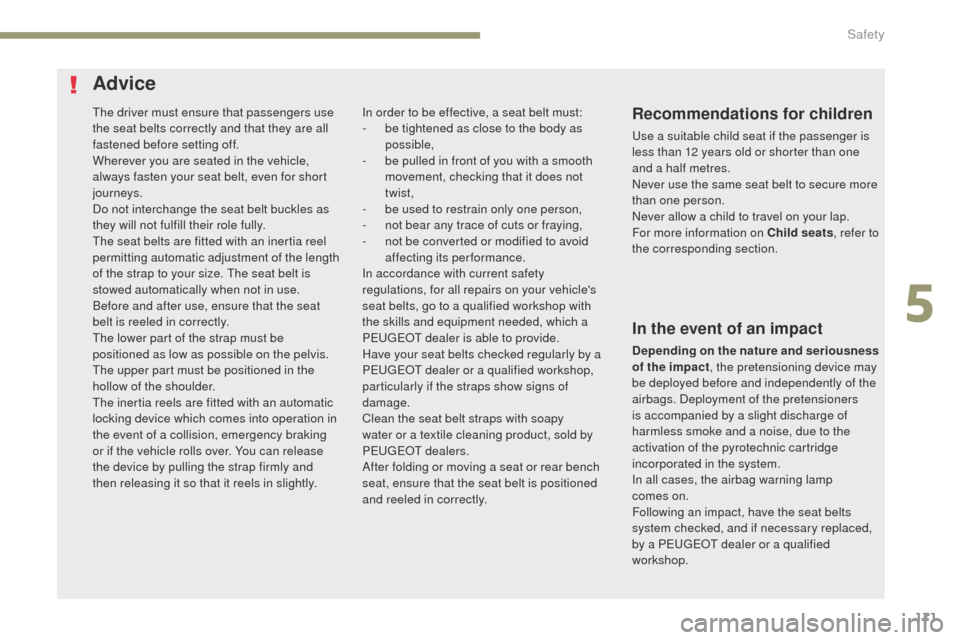
171
3008-2_en_Chap05_securite_ed01-2016
The driver must ensure that passengers use
the seat belts correctly and that they are all
fastened before setting off.
Wherever you are seated in the vehicle,
always fasten your seat belt, even for short
journeys.
Do not interchange the seat belt buckles as
they will not fulfill their role fully.
The seat belts are fitted with an inertia reel
permitting automatic adjustment of the length
of the strap to your size. The seat belt is
stowed automatically when not in use.
Before and after use, ensure that the seat
belt is reeled in correctly.
The lower part of the strap must be
positioned as low as possible on the pelvis.
The upper part must be positioned in the
hollow of the shoulder.
The inertia reels are fitted with an automatic
locking device which comes into operation in
the event of a collision, emergency braking
or if the vehicle rolls over. You can release
the device by pulling the strap firmly and
then releasing it so that it reels in slightly.Recommendations for children
Use a suitable child seat if the passenger is
less than 12 years old or shorter than one
and a half metres.
Never use the same seat belt to secure more
than one person.
Never allow a child to travel on your lap.
For more information on Child seats, refer to
the corresponding section.
In the event of an impact
Depending on the nature and seriousness
of the impact , the pretensioning device may
be deployed before and independently of the
airbags. Deployment of the pretensioners
is accompanied by a slight discharge of
harmless smoke and a noise, due to the
activation of the pyrotechnic cartridge
incorporated in the system.
In all cases, the airbag warning lamp
comes
on.
Following an impact, have the seat belts
system checked, and if necessary replaced,
by a PEUGEOT dealer or a qualified
workshop.
Advice
In order to be effective, a seat belt must:
- b e tightened as close to the body as
possible,
-
b
e pulled in front of you with a smooth
movement, checking that it does not
twist,
-
b
e used to restrain only one person,
-
n
ot bear any trace of cuts or fraying,
-
n
ot be converted or modified to avoid
affecting its performance.
In accordance with current safety
regulations, for all repairs on your vehicle's
seat belts, go to a qualified workshop with
the skills and equipment needed, which a
PEUGEOT dealer is able to provide.
Have your seat belts checked regularly by a
PEUGEOT dealer or a qualified workshop,
particularly if the straps show signs of
damage.
Clean the seat belt straps with soapy
water or a textile cleaning product, sold by
PEUGEOT dealers.
After folding or moving a seat or rear bench
seat, ensure that the seat belt is positioned
and reeled in correctly.
5
Safety
Page 174 of 566
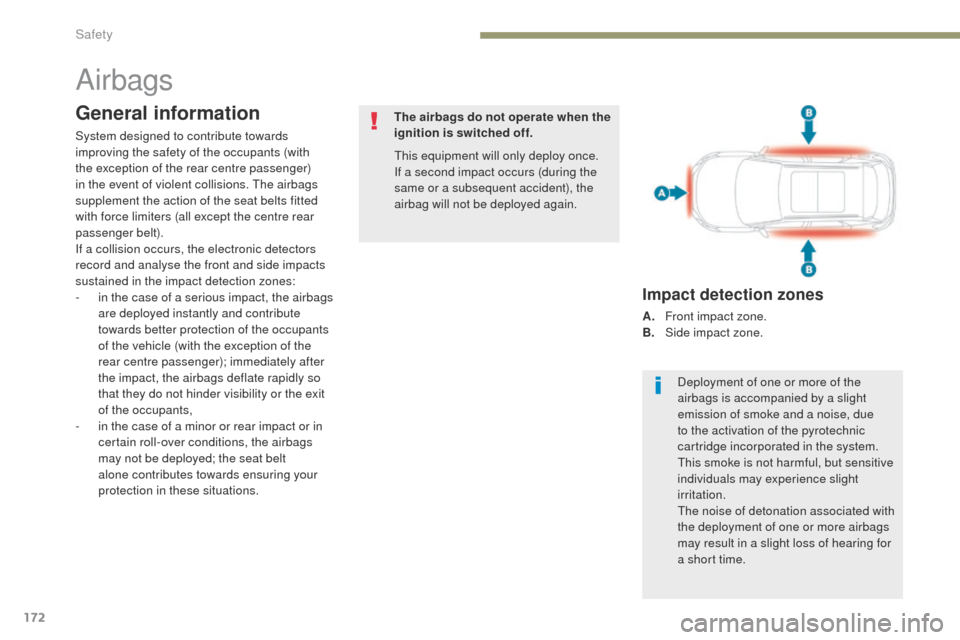
172
3008-2_en_Chap05_securite_ed01-2016
Airbags
General information
System designed to contribute towards
improving the safety of the occupants (with
the exception of the rear centre passenger)
in the event of violent collisions. The airbags
supplement the action of the seat belts fitted
with force limiters (all except the centre rear
passenger belt).
If a collision occurs, the electronic detectors
record and analyse the front and side impacts
sustained in the impact detection zones:
-
i
n the case of a serious impact, the airbags
are deployed instantly and contribute
towards better protection of the occupants
of the vehicle (with the exception of the
rear centre passenger); immediately after
the impact, the airbags deflate rapidly so
that they do not hinder visibility or the exit
of the occupants,
-
i
n the case of a minor or rear impact or in
certain roll-over conditions, the airbags
may not be deployed; the seat belt
alone contributes towards ensuring your
protection in these situations.
Impact detection zones
A. Front impact zone.
B. S ide impact zone.
The airbags do not operate when the
ignition is switched off.
This equipment will only deploy once.
If a second impact occurs (during the
same or a subsequent accident), the
airbag will not be deployed again.
Deployment of one or more of the
airbags is accompanied by a slight
emission of smoke and a noise, due
to the activation of the pyrotechnic
cartridge incorporated in the system.
This smoke is not harmful, but sensitive
individuals may experience slight
irritation.
The noise of detonation associated with
the deployment of one or more airbags
may result in a slight loss of hearing for
a short time.
Safety
Page 175 of 566
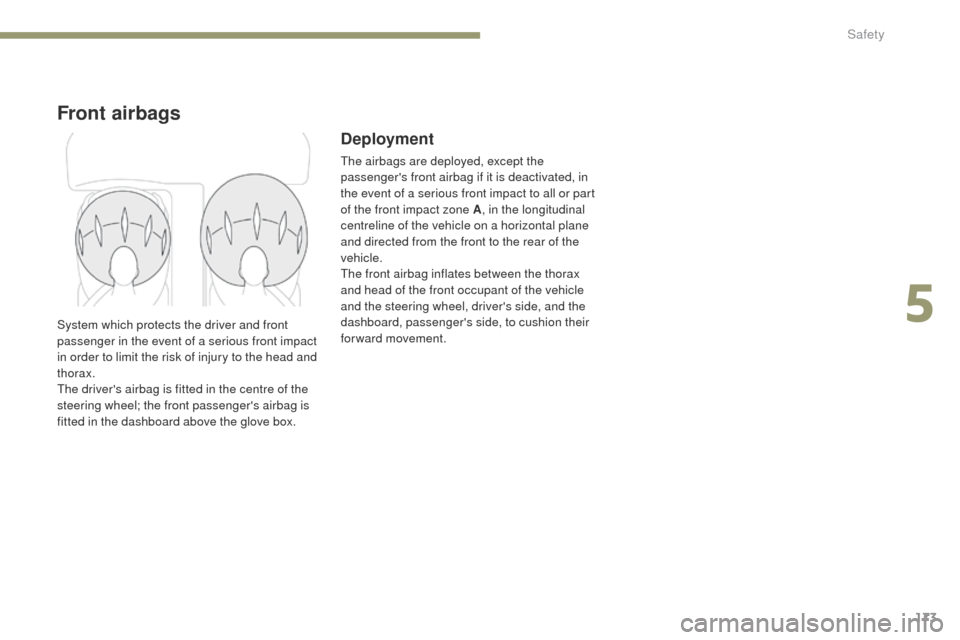
173
3008-2_en_Chap05_securite_ed01-2016
Front airbags
Deployment
The airbags are deployed, except the
passenger's front airbag if it is deactivated, in
the event of a serious front impact to all or part
of the front impact zone A, in the longitudinal
centreline of the vehicle on a horizontal plane
and directed from the front to the rear of the
vehicle.
The front airbag inflates between the thorax
and head of the front occupant of the vehicle
and the steering wheel, driver's side, and the
dashboard, passenger's side, to cushion their
for ward movement.
System which protects the driver and front
passenger in the event of a serious front impact
in order to limit the risk of injury to the head and
thorax.
The driver's airbag is fitted in the centre of the
steering wheel; the front passenger's airbag is
fitted in the dashboard above the glove box.
5
Safety